Financial Analysis Report: Comparing Projects A & B for Investment
VerifiedAdded on 2023/01/11
|9
|1247
|80
Report
AI Summary
This report provides a comprehensive financial analysis comparing two projects, Project A and Project B, for investment decisions. It begins with an introduction to the importance of financial decision-making for organizations, specifically XYZ plc in the UK, and outlines the use of payback period and Net Present Value (NPV) for project evaluation. The main body of the report details the calculation of the payback period for both projects, determining the time required to recover the initial investment. It then calculates the NPV for each project, incorporating discounted cash flow analysis to assess profitability. An analysis section follows, discussing the pros and cons of both the payback period and NPV methods, alongside the consideration of financial and non-financial factors that influence business decisions, such as profit, interest rates, political and technological factors. The report concludes by recommending investment in Project B based on the financial analysis and efficiency assessments, supported by the calculated metrics. The references section lists the sources used for the report.

BUSINESS DECISION
MAKING
MAKING
Paraphrase This Document
Need a fresh take? Get an instant paraphrase of this document with our AI Paraphraser
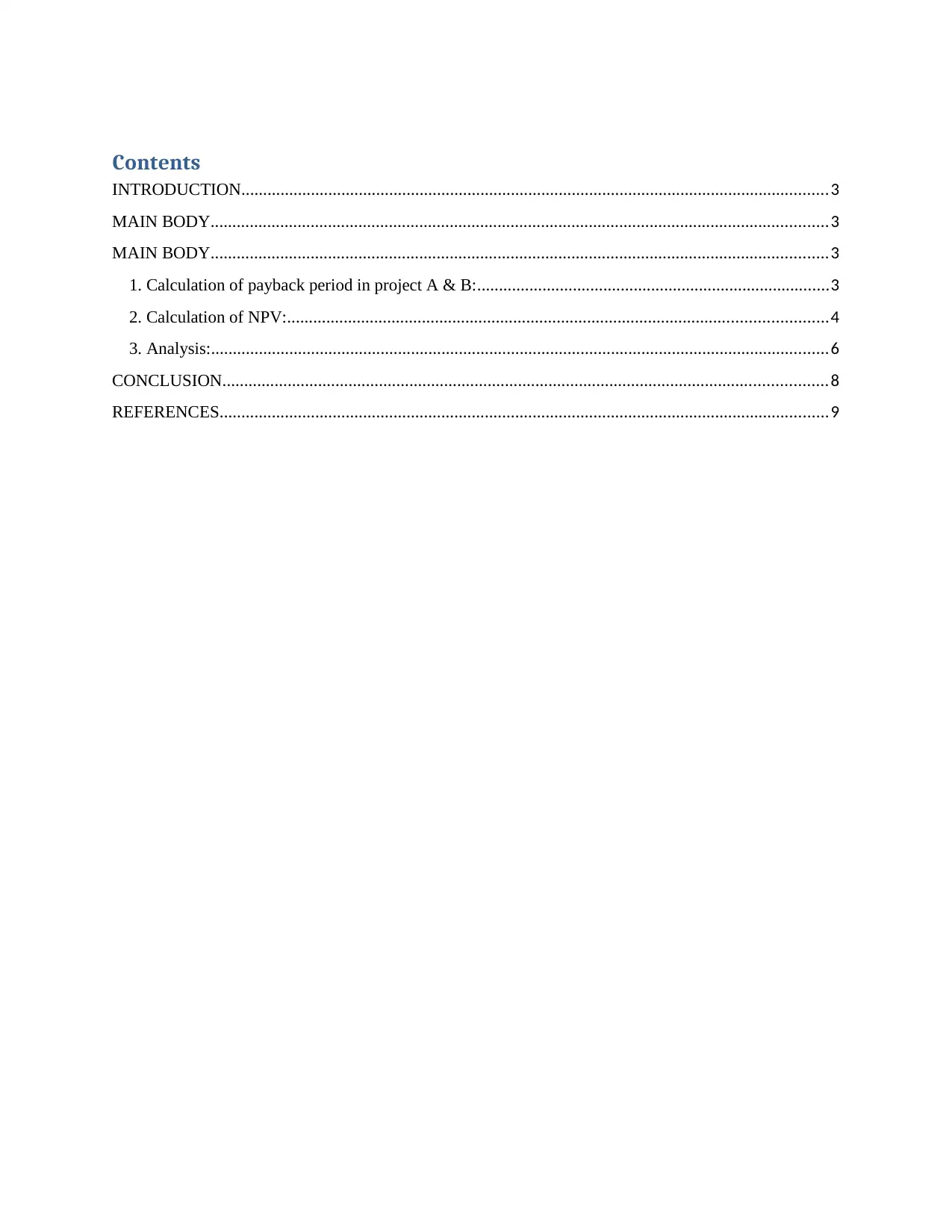
Contents
INTRODUCTION.......................................................................................................................................3
MAIN BODY..............................................................................................................................................3
MAIN BODY..............................................................................................................................................3
1. Calculation of payback period in project A & B:.................................................................................3
2. Calculation of NPV:............................................................................................................................4
3. Analysis:..............................................................................................................................................6
CONCLUSION...........................................................................................................................................8
REFERENCES............................................................................................................................................9
INTRODUCTION.......................................................................................................................................3
MAIN BODY..............................................................................................................................................3
MAIN BODY..............................................................................................................................................3
1. Calculation of payback period in project A & B:.................................................................................3
2. Calculation of NPV:............................................................................................................................4
3. Analysis:..............................................................................................................................................6
CONCLUSION...........................................................................................................................................8
REFERENCES............................................................................................................................................9
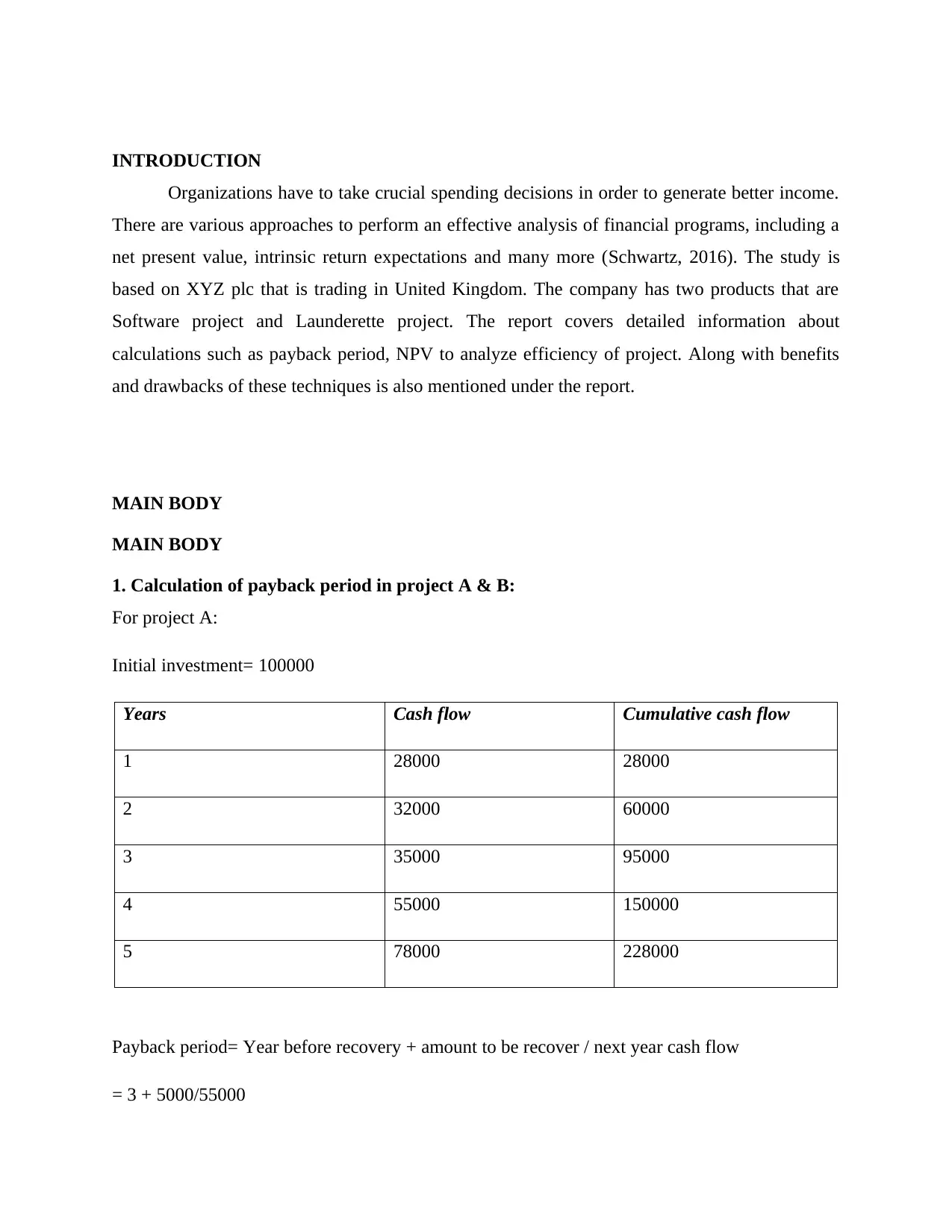
INTRODUCTION
Organizations have to take crucial spending decisions in order to generate better income.
There are various approaches to perform an effective analysis of financial programs, including a
net present value, intrinsic return expectations and many more (Schwartz, 2016). The study is
based on XYZ plc that is trading in United Kingdom. The company has two products that are
Software project and Launderette project. The report covers detailed information about
calculations such as payback period, NPV to analyze efficiency of project. Along with benefits
and drawbacks of these techniques is also mentioned under the report.
MAIN BODY
MAIN BODY
1. Calculation of payback period in project A & B:
For project A:
Initial investment= 100000
Years Cash flow Cumulative cash flow
1 28000 28000
2 32000 60000
3 35000 95000
4 55000 150000
5 78000 228000
Payback period= Year before recovery + amount to be recover / next year cash flow
= 3 + 5000/55000
Organizations have to take crucial spending decisions in order to generate better income.
There are various approaches to perform an effective analysis of financial programs, including a
net present value, intrinsic return expectations and many more (Schwartz, 2016). The study is
based on XYZ plc that is trading in United Kingdom. The company has two products that are
Software project and Launderette project. The report covers detailed information about
calculations such as payback period, NPV to analyze efficiency of project. Along with benefits
and drawbacks of these techniques is also mentioned under the report.
MAIN BODY
MAIN BODY
1. Calculation of payback period in project A & B:
For project A:
Initial investment= 100000
Years Cash flow Cumulative cash flow
1 28000 28000
2 32000 60000
3 35000 95000
4 55000 150000
5 78000 228000
Payback period= Year before recovery + amount to be recover / next year cash flow
= 3 + 5000/55000
⊘ This is a preview!⊘
Do you want full access?
Subscribe today to unlock all pages.

Trusted by 1+ million students worldwide

= 3+0.9 years
So cost of this project’s cost will be covered within 3 years and 9 months.
For project B:
Initial investment= 120000
Years Cash flow Cumulative cash flow
1 31000 31000
2 38000 69000
3 43000 112000
4 64000 176000
5 89000 265000
Payback period= 3+8000/64000
= 3+0.125
So cost of this project will be covered in 3 years and 1 month.
On the basis of above calculation, this can be stated that project B’s cost will be covered in less
time as compared to project A.
2. Calculation of NPV:
Project A:
So cost of this project’s cost will be covered within 3 years and 9 months.
For project B:
Initial investment= 120000
Years Cash flow Cumulative cash flow
1 31000 31000
2 38000 69000
3 43000 112000
4 64000 176000
5 89000 265000
Payback period= 3+8000/64000
= 3+0.125
So cost of this project will be covered in 3 years and 1 month.
On the basis of above calculation, this can be stated that project B’s cost will be covered in less
time as compared to project A.
2. Calculation of NPV:
Project A:
Paraphrase This Document
Need a fresh take? Get an instant paraphrase of this document with our AI Paraphraser
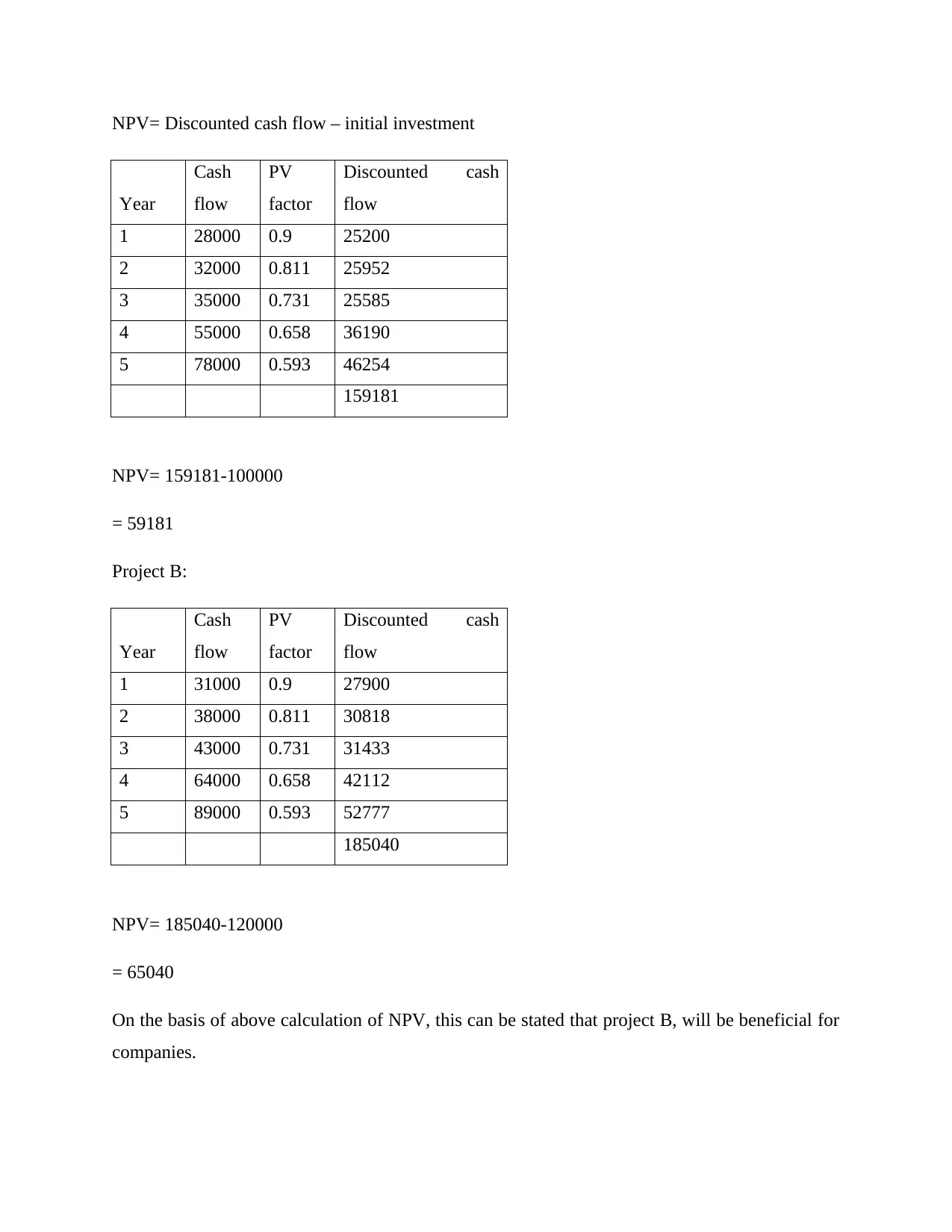
NPV= Discounted cash flow – initial investment
Year
Cash
flow
PV
factor
Discounted cash
flow
1 28000 0.9 25200
2 32000 0.811 25952
3 35000 0.731 25585
4 55000 0.658 36190
5 78000 0.593 46254
159181
NPV= 159181-100000
= 59181
Project B:
Year
Cash
flow
PV
factor
Discounted cash
flow
1 31000 0.9 27900
2 38000 0.811 30818
3 43000 0.731 31433
4 64000 0.658 42112
5 89000 0.593 52777
185040
NPV= 185040-120000
= 65040
On the basis of above calculation of NPV, this can be stated that project B, will be beneficial for
companies.
Year
Cash
flow
PV
factor
Discounted cash
flow
1 28000 0.9 25200
2 32000 0.811 25952
3 35000 0.731 25585
4 55000 0.658 36190
5 78000 0.593 46254
159181
NPV= 159181-100000
= 59181
Project B:
Year
Cash
flow
PV
factor
Discounted cash
flow
1 31000 0.9 27900
2 38000 0.811 30818
3 43000 0.731 31433
4 64000 0.658 42112
5 89000 0.593 52777
185040
NPV= 185040-120000
= 65040
On the basis of above calculation of NPV, this can be stated that project B, will be beneficial for
companies.
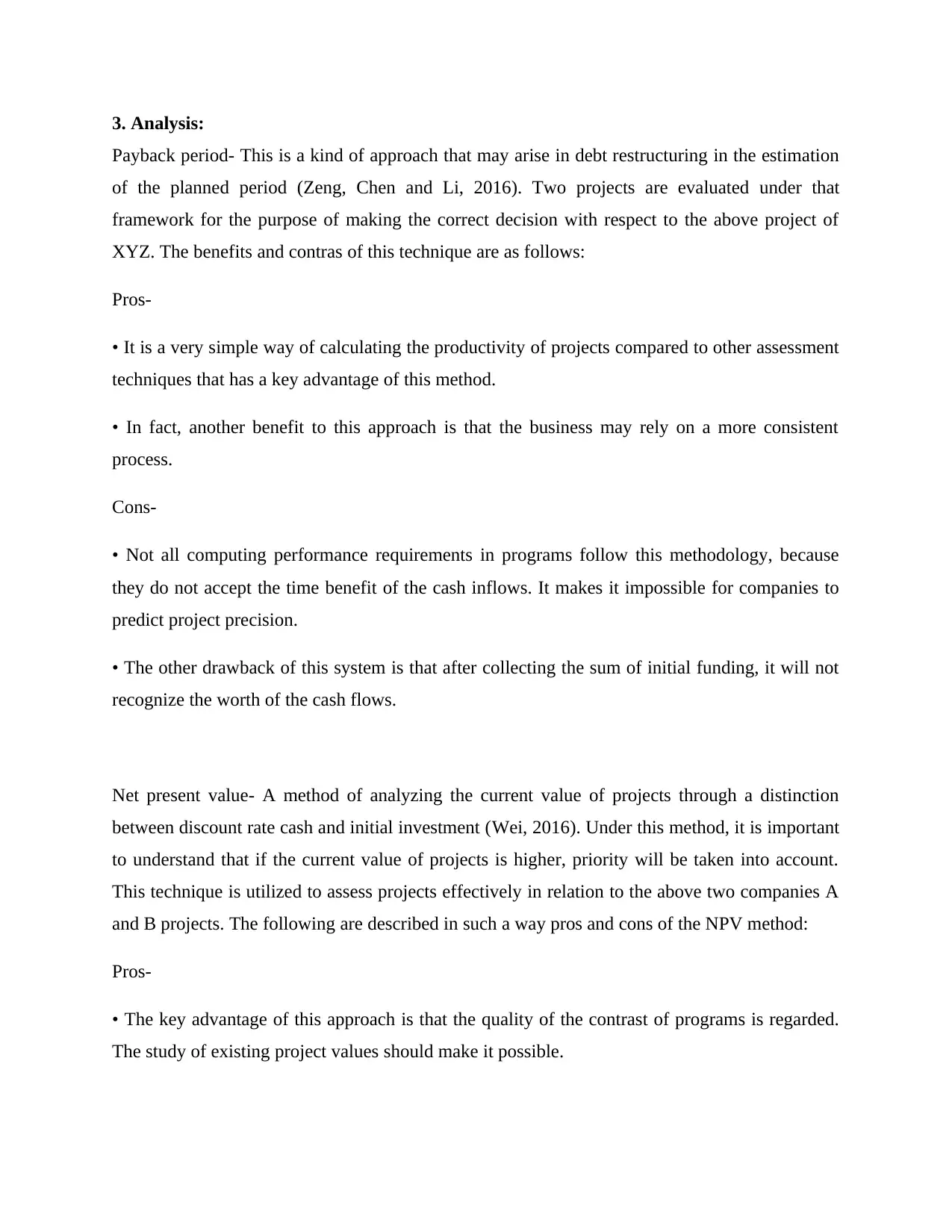
3. Analysis:
Payback period- This is a kind of approach that may arise in debt restructuring in the estimation
of the planned period (Zeng, Chen and Li, 2016). Two projects are evaluated under that
framework for the purpose of making the correct decision with respect to the above project of
XYZ. The benefits and contras of this technique are as follows:
Pros-
• It is a very simple way of calculating the productivity of projects compared to other assessment
techniques that has a key advantage of this method.
• In fact, another benefit to this approach is that the business may rely on a more consistent
process.
Cons-
• Not all computing performance requirements in programs follow this methodology, because
they do not accept the time benefit of the cash inflows. It makes it impossible for companies to
predict project precision.
• The other drawback of this system is that after collecting the sum of initial funding, it will not
recognize the worth of the cash flows.
Net present value- A method of analyzing the current value of projects through a distinction
between discount rate cash and initial investment (Wei, 2016). Under this method, it is important
to understand that if the current value of projects is higher, priority will be taken into account.
This technique is utilized to assess projects effectively in relation to the above two companies A
and B projects. The following are described in such a way pros and cons of the NPV method:
Pros-
• The key advantage of this approach is that the quality of the contrast of programs is regarded.
The study of existing project values should make it possible.
Payback period- This is a kind of approach that may arise in debt restructuring in the estimation
of the planned period (Zeng, Chen and Li, 2016). Two projects are evaluated under that
framework for the purpose of making the correct decision with respect to the above project of
XYZ. The benefits and contras of this technique are as follows:
Pros-
• It is a very simple way of calculating the productivity of projects compared to other assessment
techniques that has a key advantage of this method.
• In fact, another benefit to this approach is that the business may rely on a more consistent
process.
Cons-
• Not all computing performance requirements in programs follow this methodology, because
they do not accept the time benefit of the cash inflows. It makes it impossible for companies to
predict project precision.
• The other drawback of this system is that after collecting the sum of initial funding, it will not
recognize the worth of the cash flows.
Net present value- A method of analyzing the current value of projects through a distinction
between discount rate cash and initial investment (Wei, 2016). Under this method, it is important
to understand that if the current value of projects is higher, priority will be taken into account.
This technique is utilized to assess projects effectively in relation to the above two companies A
and B projects. The following are described in such a way pros and cons of the NPV method:
Pros-
• The key advantage of this approach is that the quality of the contrast of programs is regarded.
The study of existing project values should make it possible.
⊘ This is a preview!⊘
Do you want full access?
Subscribe today to unlock all pages.

Trusted by 1+ million students worldwide
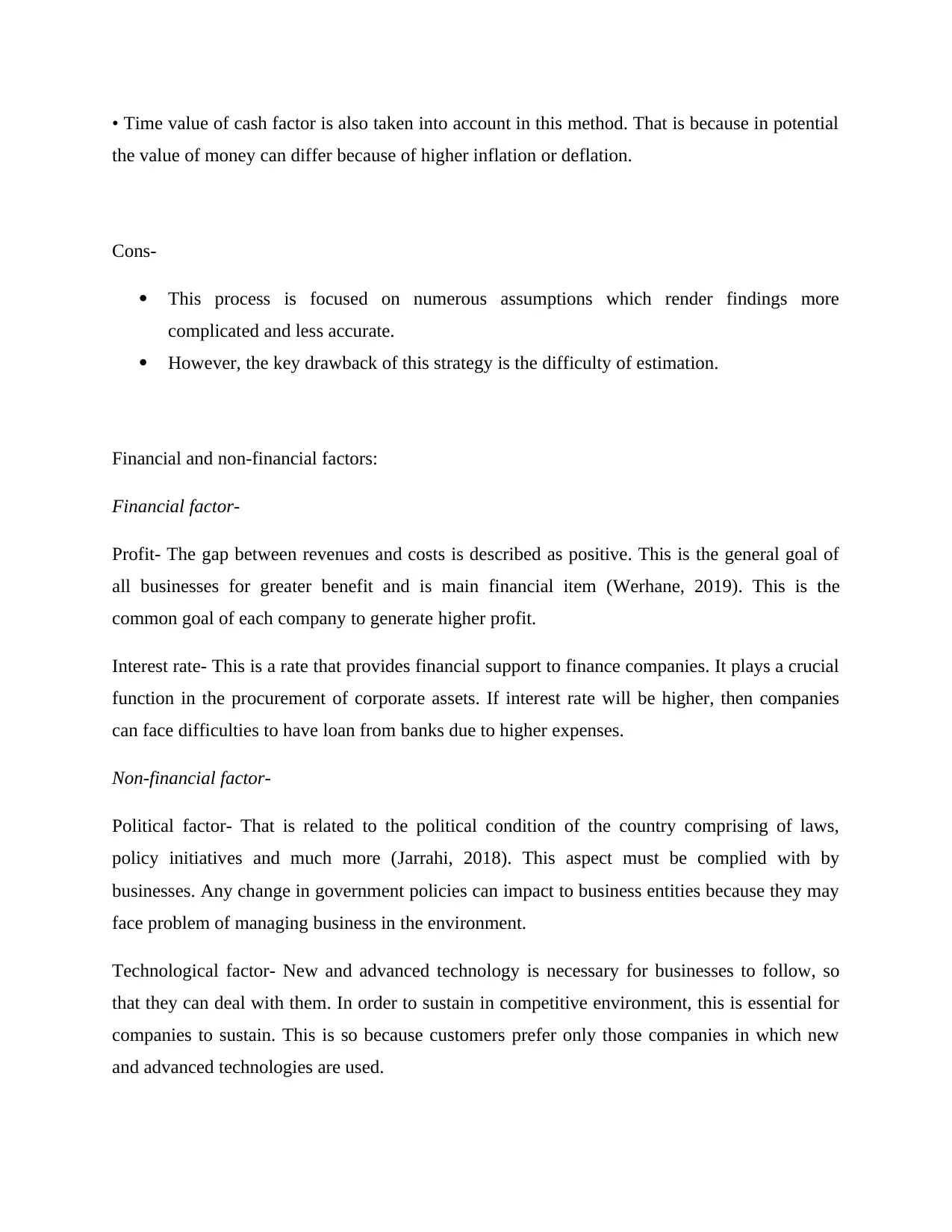
• Time value of cash factor is also taken into account in this method. That is because in potential
the value of money can differ because of higher inflation or deflation.
Cons-
This process is focused on numerous assumptions which render findings more
complicated and less accurate.
However, the key drawback of this strategy is the difficulty of estimation.
Financial and non-financial factors:
Financial factor-
Profit- The gap between revenues and costs is described as positive. This is the general goal of
all businesses for greater benefit and is main financial item (Werhane, 2019). This is the
common goal of each company to generate higher profit.
Interest rate- This is a rate that provides financial support to finance companies. It plays a crucial
function in the procurement of corporate assets. If interest rate will be higher, then companies
can face difficulties to have loan from banks due to higher expenses.
Non-financial factor-
Political factor- That is related to the political condition of the country comprising of laws,
policy initiatives and much more (Jarrahi, 2018). This aspect must be complied with by
businesses. Any change in government policies can impact to business entities because they may
face problem of managing business in the environment.
Technological factor- New and advanced technology is necessary for businesses to follow, so
that they can deal with them. In order to sustain in competitive environment, this is essential for
companies to sustain. This is so because customers prefer only those companies in which new
and advanced technologies are used.
the value of money can differ because of higher inflation or deflation.
Cons-
This process is focused on numerous assumptions which render findings more
complicated and less accurate.
However, the key drawback of this strategy is the difficulty of estimation.
Financial and non-financial factors:
Financial factor-
Profit- The gap between revenues and costs is described as positive. This is the general goal of
all businesses for greater benefit and is main financial item (Werhane, 2019). This is the
common goal of each company to generate higher profit.
Interest rate- This is a rate that provides financial support to finance companies. It plays a crucial
function in the procurement of corporate assets. If interest rate will be higher, then companies
can face difficulties to have loan from banks due to higher expenses.
Non-financial factor-
Political factor- That is related to the political condition of the country comprising of laws,
policy initiatives and much more (Jarrahi, 2018). This aspect must be complied with by
businesses. Any change in government policies can impact to business entities because they may
face problem of managing business in the environment.
Technological factor- New and advanced technology is necessary for businesses to follow, so
that they can deal with them. In order to sustain in competitive environment, this is essential for
companies to sustain. This is so because customers prefer only those companies in which new
and advanced technologies are used.
Paraphrase This Document
Need a fresh take? Get an instant paraphrase of this document with our AI Paraphraser
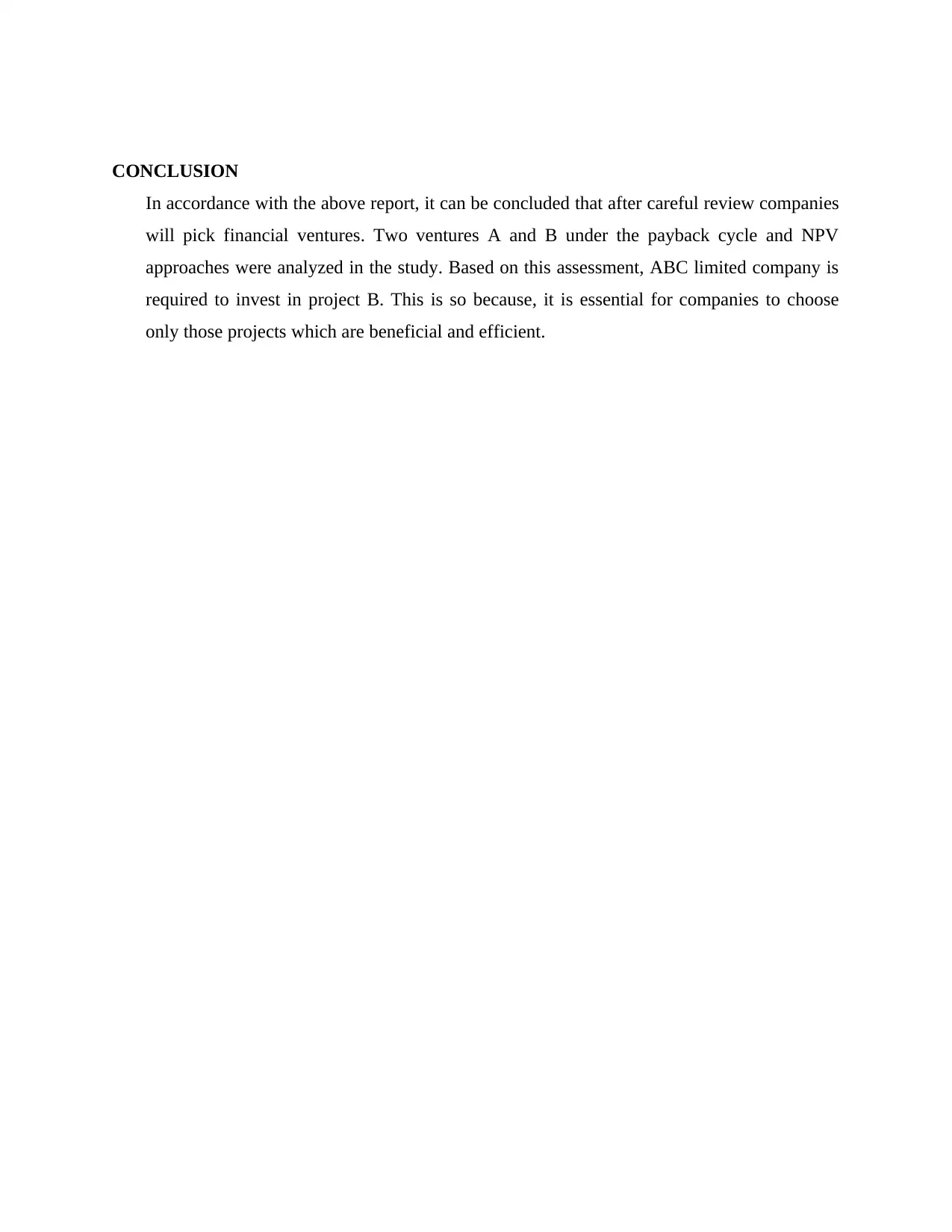
CONCLUSION
In accordance with the above report, it can be concluded that after careful review companies
will pick financial ventures. Two ventures A and B under the payback cycle and NPV
approaches were analyzed in the study. Based on this assessment, ABC limited company is
required to invest in project B. This is so because, it is essential for companies to choose
only those projects which are beneficial and efficient.
In accordance with the above report, it can be concluded that after careful review companies
will pick financial ventures. Two ventures A and B under the payback cycle and NPV
approaches were analyzed in the study. Based on this assessment, ABC limited company is
required to invest in project B. This is so because, it is essential for companies to choose
only those projects which are beneficial and efficient.
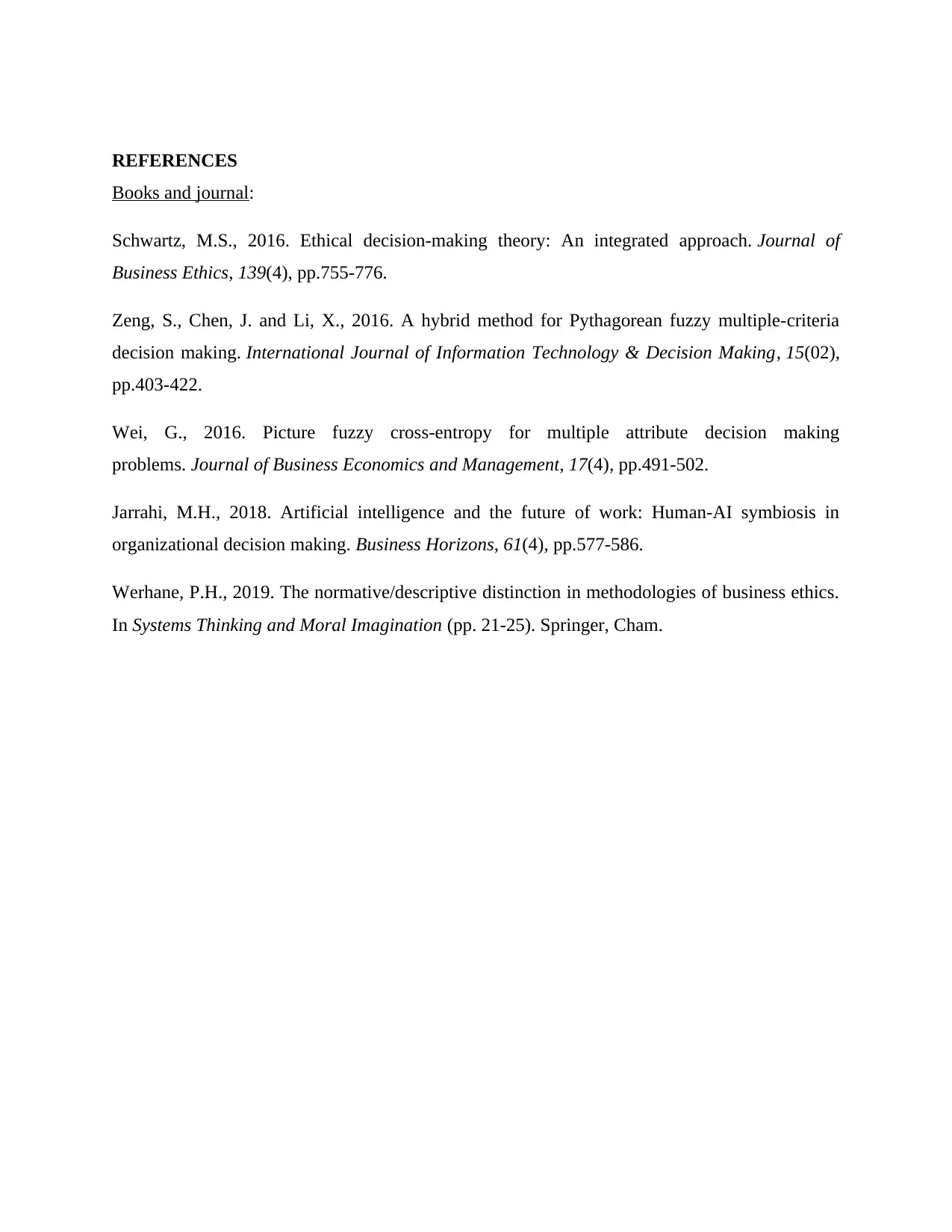
REFERENCES
Books and journal:
Schwartz, M.S., 2016. Ethical decision-making theory: An integrated approach. Journal of
Business Ethics, 139(4), pp.755-776.
Zeng, S., Chen, J. and Li, X., 2016. A hybrid method for Pythagorean fuzzy multiple-criteria
decision making. International Journal of Information Technology & Decision Making, 15(02),
pp.403-422.
Wei, G., 2016. Picture fuzzy cross-entropy for multiple attribute decision making
problems. Journal of Business Economics and Management, 17(4), pp.491-502.
Jarrahi, M.H., 2018. Artificial intelligence and the future of work: Human-AI symbiosis in
organizational decision making. Business Horizons, 61(4), pp.577-586.
Werhane, P.H., 2019. The normative/descriptive distinction in methodologies of business ethics.
In Systems Thinking and Moral Imagination (pp. 21-25). Springer, Cham.
Books and journal:
Schwartz, M.S., 2016. Ethical decision-making theory: An integrated approach. Journal of
Business Ethics, 139(4), pp.755-776.
Zeng, S., Chen, J. and Li, X., 2016. A hybrid method for Pythagorean fuzzy multiple-criteria
decision making. International Journal of Information Technology & Decision Making, 15(02),
pp.403-422.
Wei, G., 2016. Picture fuzzy cross-entropy for multiple attribute decision making
problems. Journal of Business Economics and Management, 17(4), pp.491-502.
Jarrahi, M.H., 2018. Artificial intelligence and the future of work: Human-AI symbiosis in
organizational decision making. Business Horizons, 61(4), pp.577-586.
Werhane, P.H., 2019. The normative/descriptive distinction in methodologies of business ethics.
In Systems Thinking and Moral Imagination (pp. 21-25). Springer, Cham.
⊘ This is a preview!⊘
Do you want full access?
Subscribe today to unlock all pages.

Trusted by 1+ million students worldwide
1 out of 9
Related Documents
Your All-in-One AI-Powered Toolkit for Academic Success.
+13062052269
info@desklib.com
Available 24*7 on WhatsApp / Email
![[object Object]](/_next/static/media/star-bottom.7253800d.svg)
Unlock your academic potential
Copyright © 2020–2025 A2Z Services. All Rights Reserved. Developed and managed by ZUCOL.





